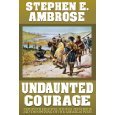More on this book
Community
Kindle Notes & Highlights
Lewis was born in a place where the West invited exploration but the East could provide education and knowledge, where the hunting was magnificent but plantation society provided refinement and enlightenment, where he could learn wilderness skills while sharpening his wits about such matters as surveying, politics, natural history, and geography.
At age eighteen, he was the head of a small community of about two dozen slaves and nearly two thousand acres of land. His lessons from now on would be in management, in soils, crops, distillery, carpentry, blacksmithing, shoemaking, weaving, coopering, timbering, in killing, dressing, and skinning cattle and sheep, preserving vegetables and meats, repairing plows, harrows, saws, and rifles, caring for horses and dogs, treating the sick, and the myriad of other tasks that went into running a plantation.
“Lewis and Clark Meeting Daniel Boone” sounds like a Charley Russell painting, or a marvelous scene for a novel. But had he met Boone, surely Clark would have written about it.
“Soon after he shot a buffaloe cow,” Lewis wrote, and “broke her thy, the cow pursued him he conceal himself in a small raviene.” The little incident highlighted a major problem for the hunters. After they had fired their rifles, they were nearly helpless until they reloaded.
The soldiers, meanwhile, enjoyed the favors of the Arikara women, often encouraged to do so by the husbands, who believed that they would catch some of the power of the white men from such intercourse, transmitted to them through their wives. One warrior invited York to his lodge, offered him his wife, and guarded the entrance during the act. York was said to be “the big Medison.” Whether the Indians got white or black power from the intercourse cannot be said, but what they had gotten for sure from their hospitality to previous white traders was venereal disease, which was rampant in the
...more


